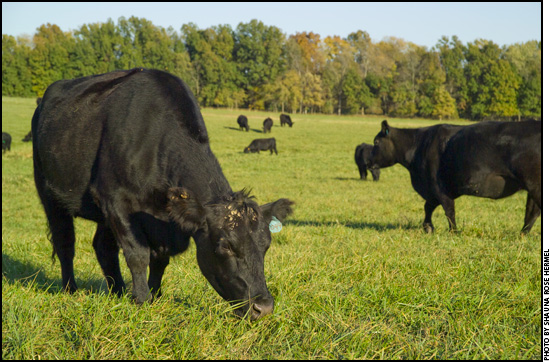 Match Cows to Forage Resources
Match Cows to Forage Resources
Performance predictors offer assistance in selecting appropriate milk levels, growth and carcass considerations.
Commercial cow-calf operators must become more cost-efficient to maintain or improve profit margins, making matching animals to forage resources more important than ever. Land, fertilizer, feed, fuel and labor costs continue to increase relative to the value of carcass beef and weaned calves, reminds David Lalman, Oklahoma State University (OSU) professor of animal science.
"One logical solution is to select and breed cattle that are productive in a given environment while requiring minimal labor and supplemental feed inputs," he says.
Planned crossbreeding systems have been shown to increase lifetime kilogram of calf weight weaned by 25% compared to purebred cows. Nevertheless, breed association registration records suggest that the use of planned crossbreeding systems in the United States has declined in recent years.
"Industry trends suggest that standard genetic prediction tools such as expected progeny differences (EPDs) and selection indexes have been embraced by producers, leading to substantial change in the past 15 to 20 years," Lalman says.
For example, the genetic trend for weaning and yearling growth, marbling and ribeye area EPDs have increased dramatically in each of the five breeds of cattle with the greatest number of registrations in the United States. Concurrently, the genetic trend for birth weight and mature cow size appears to have stabilized.
Optimums vs. maximums
"While many of the genetic changes likely represent positive trends in commercial cow-calf enterprise profitability, some trends require closer scrutiny by academic and industry leaders," Lalman says. "As an example, the genetic trend for increased milk yield continues at an alarming rate in several popular breeds."
Lalman classifies the trend as "remarkable" given the increased requirements for maintenance energy, production energy, crude protein and forage dry-matter intake associated with increased milk yield.
"Within-breed adjustment factors for maintenance energy requirements associated with increased milk yield are needed," he says. "Recent research suggests that in some environments, forage quality limits expression of full genetic potential for milk yield. This scenario should lead to no improvement in calf weaning weight while cow maintenance costs continue to increase."
The American Angus Association offers the Optimal Milk Module (www.angus.org/Performance/OptimalMilk/OptimalMilkMain.aspx) as an online resource for producers to discover the ideal milk EPD range they should seek in the bulls they purchase as sires. The module allows the producer to input information about the current herd and feed resources available to estimate a desired milk EPD range for their circumstance.
Carcass, growth and maturity considerations
Lalman says continued selection for increased muscling and increased growth also should be scrutinized for their potential effect on beef cow efficiency.
"In general, mature size of purebred cows has hit a plateau and may even have declined a bit over the past 10 years," he says. "Commercial cow size typically lags behind by several years."
Considering the extremely large-framed cattle that were around in the late 1980s, cows are large and heavy today, but not extreme in frame size.
"Still, there are individual producers who have not kept as close an eye on cow size as they should have been," Lalman says. "To expect large, heavy-milking cows to be in moderate body condition at calving and maintain condition through breeding, they must receive more feed than small, lighter-milking cows."
As a practical matter, reduced stocking rates will be necessary on improved pastures if lower amounts of fertilizer are applied. A larger mature cow size also affects the principle of percent of body weight needed for heifers to reach puberty.
For a cow that eventually will weigh 1,000 pounds (lb.), the target weight for the heifer would be 650 lb. For a cow that eventually will weigh 1,250 lb., the target weight would be 812 lb. going into the heifer's first breeding season, if the producer is to promote a high cycling and pregnancy rate.
The American Angus Association offers its dollar value indexes ($Values) to put into economic context an animal's predicted performance and value to the herd through weaning ($W), in the feedlot ($F), on a carcass grid ($G), or as a combination of postweaning and carcass value ($B). Included in $W is an estimate for cow efficiency ($EN); and within $G there are estimates for value contributed by yield grade traits ($YG) and quality grade traits ($QG).
By using a combination of $W and $B, producers can balance maternal and preweaning growth traits with feedlot performance and carcass value.
To clarify, index values are not to be used individually as a dollar value received, but in comparison to other animals. So, all else being equal, if Bull A has a $W of $24.15 and Bull B has a $W or $27.25, the progeny of Bull B would be expected to generate $3.10 per head more in value, on average, than the progeny of Bull A. Learn more about $Values at www.angus.org/Performance/Default.aspx.
Customized $Values are available to members and affiliates (non-members who have received a registration transfer) through the interactive tab of AAA Login (www.angusonline.org). This feature allows the producer to set certain input costs or herd traits to establish values most appropriate to their situation.
Additional cow-calf management tips are available through OSU's Division of Agricultural Sciences and Natural Resources at http://cowcalfcorner.okstate.edu/ on the Internet.





